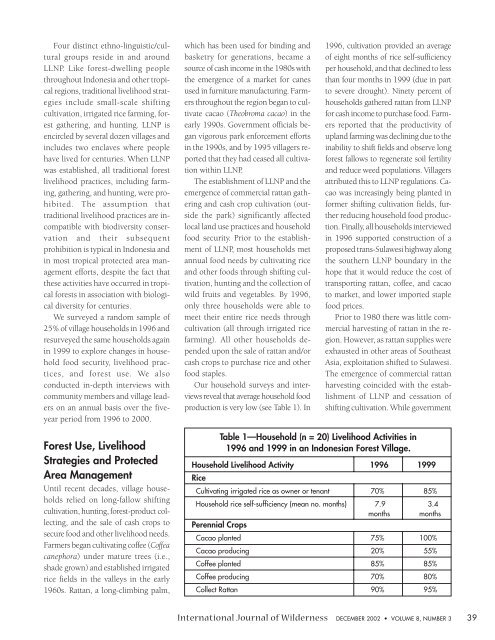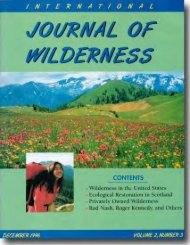Download full PDF - International Journal of Wilderness
Download full PDF - International Journal of Wilderness
Download full PDF - International Journal of Wilderness
You also want an ePaper? Increase the reach of your titles
YUMPU automatically turns print PDFs into web optimized ePapers that Google loves.
Four distinct ethno-linguistic/cultural<br />
groups reside in and around<br />
LLNP. Like forest-dwelling people<br />
throughout Indonesia and other tropical<br />
regions, traditional livelihood strategies<br />
include small-scale shifting<br />
cultivation, irrigated rice farming, forest<br />
gathering, and hunting. LLNP is<br />
encircled by several dozen villages and<br />
includes two enclaves where people<br />
have lived for centuries. When LLNP<br />
was established, all traditional forest<br />
livelihood practices, including farming,<br />
gathering, and hunting, were prohibited.<br />
The assumption that<br />
traditional livelihood practices are incompatible<br />
with biodiversity conservation<br />
and their subsequent<br />
prohibition is typical in Indonesia and<br />
in most tropical protected area management<br />
efforts, despite the fact that<br />
these activities have occurred in tropical<br />
forests in association with biological<br />
diversity for centuries.<br />
We surveyed a random sample <strong>of</strong><br />
25% <strong>of</strong> village households in 1996 and<br />
resurveyed the same households again<br />
in 1999 to explore changes in household<br />
food security, livelihood practices,<br />
and forest use. We also<br />
conducted in-depth interviews with<br />
community members and village leaders<br />
on an annual basis over the fiveyear<br />
period from 1996 to 2000.<br />
Forest Use, Livelihood<br />
Strategies and Protected<br />
Area Management<br />
Until recent decades, village households<br />
relied on long-fallow shifting<br />
cultivation, hunting, forest-product collecting,<br />
and the sale <strong>of</strong> cash crops to<br />
secure food and other livelihood needs.<br />
Farmers began cultivating c<strong>of</strong>fee (C<strong>of</strong>fea<br />
canephora) under mature trees (i.e.,<br />
shade grown) and established irrigated<br />
rice fields in the valleys in the early<br />
1960s. Rattan, a long-climbing palm,<br />
which has been used for binding and<br />
basketry for generations, became a<br />
source <strong>of</strong> cash income in the 1980s with<br />
the emergence <strong>of</strong> a market for canes<br />
used in furniture manufacturing. Farmers<br />
throughout the region began to cultivate<br />
cacao (Theobroma cacao) in the<br />
early 1990s. Government <strong>of</strong>ficials began<br />
vigorous park enforcement efforts<br />
in the 1990s, and by 1995 villagers reported<br />
that they had ceased all cultivation<br />
within LLNP.<br />
The establishment <strong>of</strong> LLNP and the<br />
emergence <strong>of</strong> commercial rattan gathering<br />
and cash crop cultivation (outside<br />
the park) significantly affected<br />
local land use practices and household<br />
food security. Prior to the establishment<br />
<strong>of</strong> LLNP, most households met<br />
annual food needs by cultivating rice<br />
and other foods through shifting cultivation,<br />
hunting and the collection <strong>of</strong><br />
wild fruits and vegetables. By 1996,<br />
only three households were able to<br />
meet their entire rice needs through<br />
cultivation (all through irrigated rice<br />
farming). All other households depended<br />
upon the sale <strong>of</strong> rattan and/or<br />
cash crops to purchase rice and other<br />
food staples.<br />
Our household surveys and interviews<br />
reveal that average household food<br />
production is very low (see Table 1). In<br />
1996, cultivation provided an average<br />
<strong>of</strong> eight months <strong>of</strong> rice self-sufficiency<br />
per household, and that declined to less<br />
than four months in 1999 (due in part<br />
to severe drought). Ninety percent <strong>of</strong><br />
households gathered rattan from LLNP<br />
for cash income to purchase food. Farmers<br />
reported that the productivity <strong>of</strong><br />
upland farming was declining due to the<br />
inability to shift fields and observe long<br />
forest fallows to regenerate soil fertility<br />
and reduce weed populations. Villagers<br />
attributed this to LLNP regulations. Cacao<br />
was increasingly being planted in<br />
former shifting cultivation fields, further<br />
reducing household food production.<br />
Finally, all households interviewed<br />
in 1996 supported construction <strong>of</strong> a<br />
proposed trans-Sulawesi highway along<br />
the southern LLNP boundary in the<br />
hope that it would reduce the cost <strong>of</strong><br />
transporting rattan, c<strong>of</strong>fee, and cacao<br />
to market, and lower imported staple<br />
food prices.<br />
Prior to 1980 there was little commercial<br />
harvesting <strong>of</strong> rattan in the region.<br />
However, as rattan supplies were<br />
exhausted in other areas <strong>of</strong> Southeast<br />
Asia, exploitation shifted to Sulawesi.<br />
The emergence <strong>of</strong> commercial rattan<br />
harvesting coincided with the establishment<br />
<strong>of</strong> LLNP and cessation <strong>of</strong><br />
shifting cultivation. While government<br />
Table 1—Household (n = 20) Livelihood Activities in<br />
1996 and 1999 in an Indonesian Forest Village.<br />
Household Livelihood Activity<br />
Rice<br />
1996 1999<br />
Cultivating irrigated rice as owner or tenant 70% 85%<br />
Household rice self-sufficiency (mean no. months) 7.9 3.4<br />
months months<br />
Perennial Crops<br />
Cacao planted 75% 100%<br />
Cacao producing 20% 55%<br />
C<strong>of</strong>fee planted 85% 85%<br />
C<strong>of</strong>fee producing 70% 80%<br />
Collect Rattan 90% 95%<br />
<strong>International</strong> <strong>Journal</strong> <strong>of</strong> <strong>Wilderness</strong> DECEMBER 2002 • VOLUME 8, NUMBER 3 39










